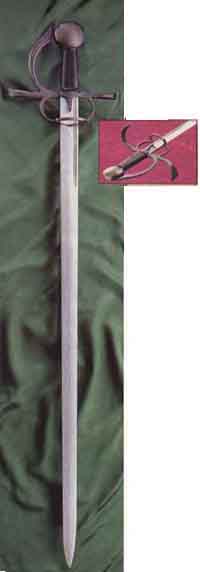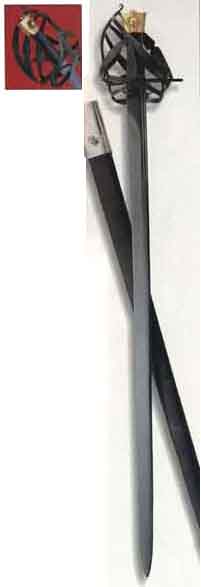 |
JL's Scimitar
The long, sweeping blade curve is superb for drawcuts and lethal for
slashing. This 31 1/2" long blade has a strong and well-developed
back edge, plus a narrow fuller on each side. Hand forged in India by
Windlass Steelcrafts. Curved hardwood grip is inletted for the star-shaped
brass guard. The Scimitar is believed to be derived from the curved sword
of the Steppes of Russia. Rare until the Mongol invasion in the 13th century,
curved swords then became prevalent from Turkey to Burma.
Circa 1550 - 1650
|
 |
Bryan's Backsword
In the 16th century, an unusual combination of design elements in this
military-style sword made it very popular all across the continent, especially
in Germany, Italy, and Spain. This sword has a single edge blade which
was coveted because it was easier to produce and because the single edge
could be made sharper due to the longer angle of the bevel. The long,
straight profile provided excellent cutting power, but with a thrusting
point.
The blade lenght--37"--was carefully chosen to be ideal for the
cavalryman, but not too long to be used by the infantry. the simple, recurved
crossguard and knuckle bow protected the hand without being cumbersome.
There is even a side ring to guard the finger should it be extended over
the cross.
All in all it's a streamlined, well-thought-out sword design that fighting
men of all stations prized.
Circa 1575
|
 |
Jim's Schiavona
The Schiavona is one of the most beautiful of all the basket-hilt swords.
Originally used by the Slavic Mercenaries hired by the Doge of Venice,
the Schiavona proved to be such an effective and attractive sword that
it was soon in use all throughout Europe.
Interestingly enough, in Drummond's famous book, "Ancient Scottish
Weapons", there are several Schiavonas, many of which are of
the style that we decided to replicate. This sword, hand forged in India
by Windlass Steelcrafts, has a steel basket, and the traditional brass
catshead pommel. Both basket and blade are blued. The single-edged blade
is well balanced and tempered. The Schiavona, like it's contemporary,
the Claymore, was a cut and thrust sword, and although used alone, frequently
a light buckler or target was also employed.
Circa 1630 - 1650
|